at Bridwell Library
Note to the Readers from the Curator
The A. V. Lane Museum purchased a number of cuneiform tablets over the course of several years beginning in 1929, mostly from Dr. Edgar James Banks. In 1933, Professor I. H. Hicks sent twelve of the tablets to Samuel I. Feigin at the Oriental Institute at the University of Chicago for translations. For many years, the Tablets were on display as part of the A.V. Lane Museum collection. They were relocated to Bridwell Library when the Lane Museum merged with the library's own collection. Several of these tablets are of special historical interest, as they originate from the site of Abu Jamous, near Babylon; comparatively few tablets have been found at this site. Over the years the tablets have been exhibited and moved many times and identifications are no longer certain. Please email comments or corrections to Special Collections. Thank you.
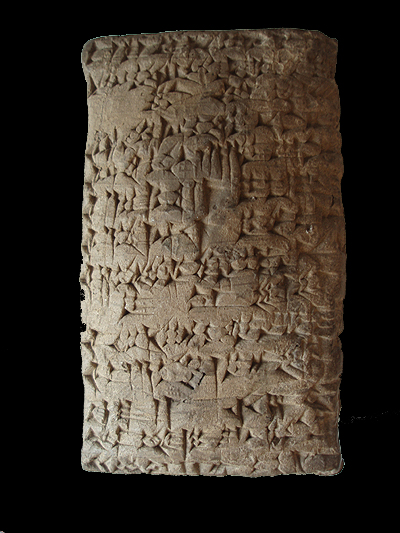
Tablet from a ruin called Abu Jamous, near Babylon, where but few tablets have been discovered. They are of a greater historical value than those from ruins like Drehm or Jokha, where many tablets have been found. 2000 B.C. Cuneiform writing is very distinct. Tan in color, 9 cm. long by 5 cm. wide by 3 cm. thick.
Summary:
Hammurabi-rim-[i1i?], the son of Sin-magir, bought 3 1/2(?) sar of built house from Ilushu-naeir, the son of Ingur-Shamash, for 6 1/2 shekels of silver. The seller and all his heirs swore never to contest the sale. Seven witnesses, the first of them an “anointer.”
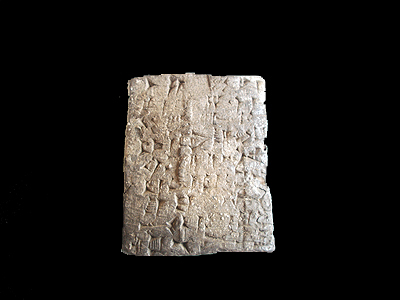
Tablet from a ruin called Abu Jamous, near Babylon.(see note on one above)
This one is almost a lead color on one side and the other has a streak of lead color and the other corner is much lighter. 6 cm. long by 5 cm. wide by 2.5 cm. thick
Summary:
The farmer Zurnakum borrows 1 kor 180 qas of barley fran the shepherd
Siya to pay the wages of his five worbuen for one day. The farmer Belier’i
seals
it in the name of Zumakuin, The debt is to be paid in harvest iime• Three
witnesses.
| 1. 1 + 180 še-gur | 1 kor 180 (qas) of barley |
| 2. kal-bi 5 u4-l-šè | its workmen are five for one day; |
| 3. se-gur10-dè | in the harvest of barley, |
| 4. sag-bi ge-ge-dam | its capital he will return |
| 5. ki Si-a-a na-qad-ta | fran Siya, the shepherd, |
| 6. Zu-ma-ku-um engar | Zumakum, the farmer |
| 7. šu-ba-ti | has borrowed for himself. |
| 8. mu Zu-ma-ku-um-šè | For the name of Zumakun |
| 9. kišib Be-1í-re’i engar | the seal of Beli-re’i, the farmer. |
| 10. Ilu-ta-bi | Ilu-tâbi; |
| 11. ur-dSul-pa-è aškab | Ur-Shulpae, the shoemaker; |
| 12. A-da-làl | Adalal |
| 13. lù-inim-ma-bi-me | are its witnesses |
| 14. mu dGimil-dSin | the year in which the deified Gimil-Sin, |
| 15. lugal uriki-ma | the king of Ur, |
| 16. ma-da Za-ab-ša-li | in which the land of Zabshali |
| 17. im-mu-hul-a | has devastated. |
Bibliographic description:
4cm. long by 4 wide by 1.5 cm thick
Summary:
Gjjujl-Njnshubur borrows 10
shekels of silver from Si
| 1. 10 gìn kù-babbar | 10 shekels silver, |
| 2. ki Si-a-a-ta | from Siya |
| 3. Gimil-dNin-Šubur | Gimil-Ninshubur |
| 4. šu-ba-ti | has borrowed. |
| 5. igi Ga-zu-a hum | Before Gazua, the grinder; |
| 6. igi Nu-úr-ì-1í | before Nûr-ili; |
| 7. igi Gimil-Ma-ma | before Gimil-Mama. |
| . itu Gi-dug-ga | The month “the good reed.” |
Note: The provenance is according to the statement of the dealer Abu-Jamous.
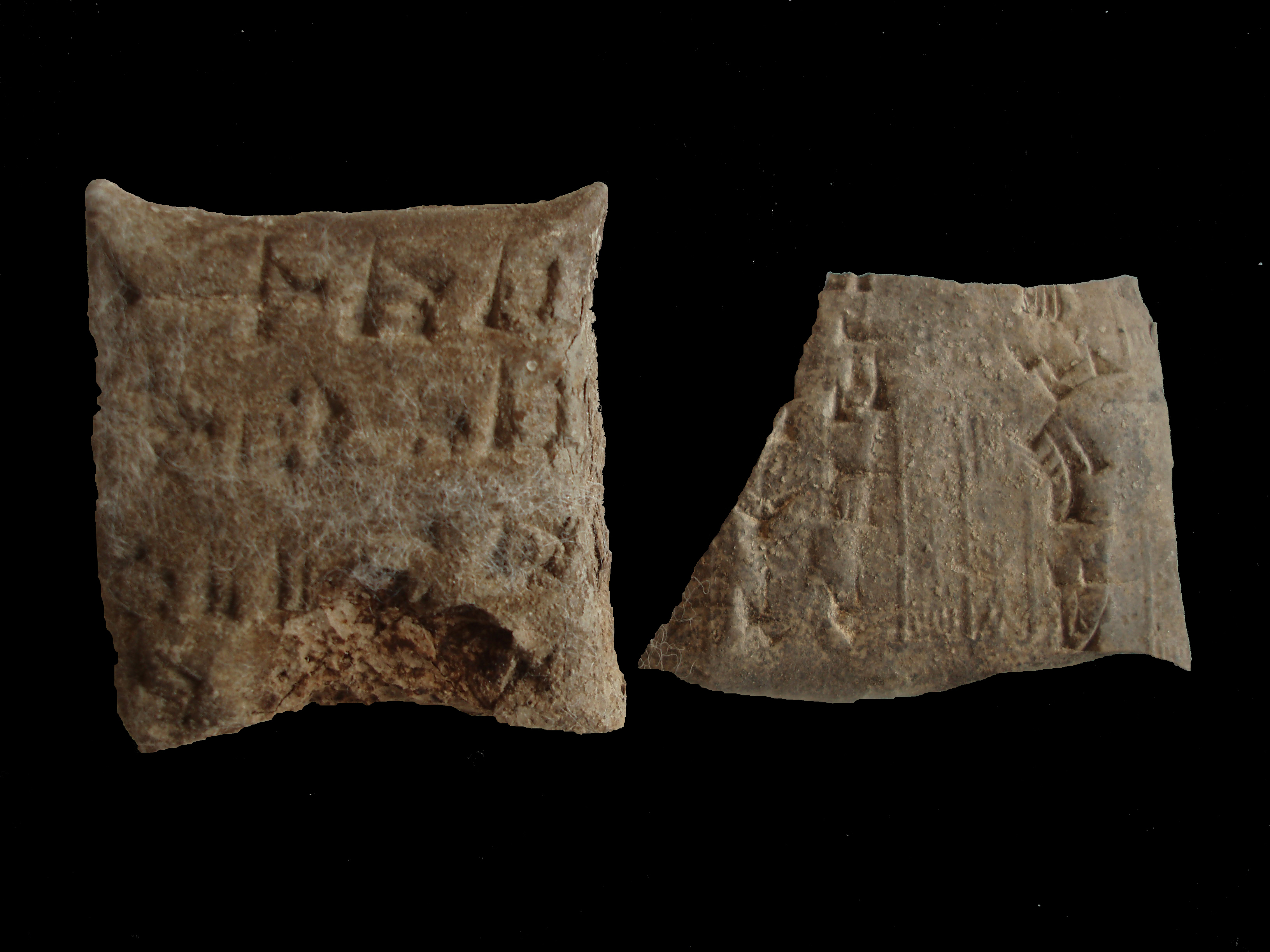
Bibliographic description:
Inventory Tablet belonging to the ear1ier part of the Ur
III
Dynasty
or the latter part of the Dynasty of Akkad (the first half of the third
millenium B.C.) 8.5 cm long by 5 cm wide by 2.5 cm thick.
Summary:
The tablet consists
of an inventory
of sheep and lambs. The first eight
lines
(the first line is completely broken) list a number
of
sheep and lambs which had been received from various individuals; the
total is
stated in the especially spaced line following. The tablet then continues with a detailed description of the uses
to which these animals were put; thus: 9 were taken as royal tax; others
were set aside for individuals or places mentioned. The following
is the transliteration and translation of the legible portions of the
tablet (dots indicate either a break or illegibility due to the condition
of the tablet)
| Obverse | |
| 1. ...................................... | ...................................... |
| 2. 3...................................... | ...................................... |
| 3. 2 sila |
2 lambs from ................ |
| 4. 1
sila |
1 lambs from ................ |
| 5. 2 sila4 ki-AŠ.KU ............ | 2 lambs from ................. |
| 30 sheep from .............. | |
| 7. 6 udu mu-tum GÌR ki ....... | 6 sheep brought by the official from ....... |
| 8. 1 sila4 ki-la-te -ni(?)-?-ta | 1 lamb from .......... |
| 9. 60 + 30 + 3 | 93(total) |
| From their midst (the following were removed for specialized purposes) | |
| 11. 3 udu sá-du | 3 sheep, the satuqqu offering |
| 12. 3 sila4 dnin-kù-nu-na | 3 lambs for dninkununa |
| 13. 1 sila4 ?-ka | 1 lamb for ........... |
| 14. 2 Sila4 dlugal- u4- da | 2 lambs for dLugaludda |
| 15. 10-lal-l | 9 (total) |
| Reverse | |
| 1. zi-ga lugal | royal tax |
| 2. 10 udu šà-é-gal-še AS.KU-da (?)-lum(?) | 10 sheep to the palace .......... |
| 3. ... udu.ká.nanna(?) | ... sheep to the gate of Nanna(?) |
| 4. 2 udu ... dam(?) a-la-mu | 2 sheep ... the wife? of Alamu |
| 5. 1 udu lal-ni a-la-mu... | 1 sheep... |
| 6. 10 + 3 | 13 |
| 7. 16 ....da.......gub-ba | ......stationed at ........ |
| 8. 5 ........... | .............. |
| 18 sheep | |
| 10. 17 ...... šabra ....... | 17 sheepp |
uncertain whether the last line and lower edge were inscribed.
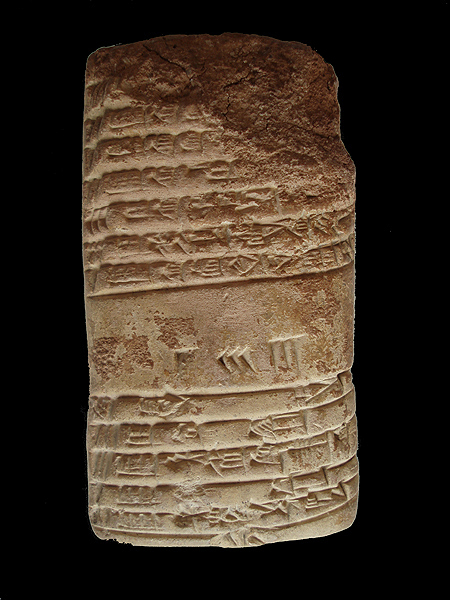
2 cm long by 2 cm wide by 1 cm thick.
Summary:
Shulgi-urtmiu
receives from Zubaga three killed sheep, namely, one goat, one lamb, and one
milk lamb for the 16th day.
| Obverse. | |
| 1. l uz | one goat |
| 2. 1 silá | one lamb |
| 3. 1 silá-ga | one milk lamb |
| 4. ba-úš u4 16-kam | killed ones, (for) the 16th day |
| 3. ki Zu-ba-ga-ta | from Zubaga |
| Reverse. | |
| dŠul-gi-uru-mu | Shulgi-urumu |
| 7. šu-ba-ti | has received. |
| 8. itu Maš-dù-kú | The month Mashduku (1st) |
| 9. mu en dNannar | year: the high priest of Nannar |
| 10. kar-zi-da ba-túg | of Karzida was invested |
| Left edge. | |
| udu | 3 sheep. |
Note: : For the
same men see G. Contenau, Contribution a l’histoire
Economique d' Umma
Bibliographic description:
4 cm
long by 4 cm wide by 1.5 cm thick.
Summary:
ob.
(1)1 Pi zì-gu-lugal
60 royal qa of gu-flour
(2) ki šeš-a-ni-ta
from his brother
(3) kišib
Igi-uru-šu-dù(?)
The seal of Igi-urushudu(?);
(4) šà-bal-a
In the store house(?)
rev.
(5) mu en dNannar
The year: The high priest of Nannar
(6) maš-e
ì-pà
by a sign was chosen.
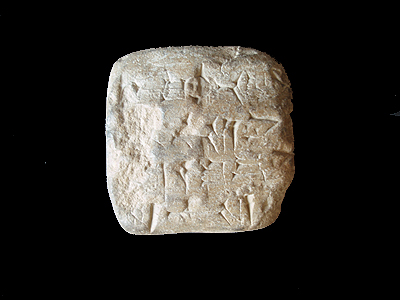
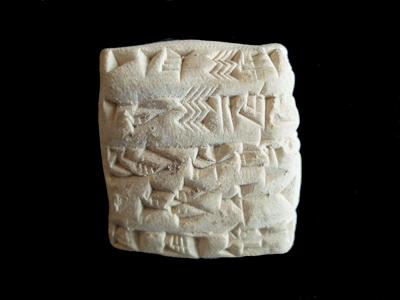
Smallest tablet, almost white and very clear writing. 3 cm long by 3 cm wide by 1 cm thick.
Summary:
Eri-du, which he has
apparently leased from its owner for a certain amount of barley.
| (1) 1 + 90 še-gur lugal | 1 kor 90 qa barley in the royal gur |
| (2) lal-ni še a-šà Eri-du7 | the balance of the barley of the field of Eridu, |
| (3) Lú-dingir-ra dumu | Lu-dingirra, the son of |
| (4) He-ti | Heti |
| (6) su-su-dam | he shall add (pay) |
| (6) mu Ur-bi (l)- | the year Urbillum |
| (7) lum ba-hul | was devastated.. |
Bibliographic Description:
Almost white. The small one at the left goes inside the broken one at right.
3 cm long by 3.5 cm wide by 1 cm thick.
Summary:
Abil-Ati borrowed from Lu-Innini 4 kors barley, the
wages of a hireling.
| (1) 4 še-gur lugal | 4 kors barley in the royal measure |
| (2) ki Lú-dInnini-ka | Lu-Innini |
| (3) á lú hun-gá | the wages of a hireling |
| (4) A-bil-A-ti | Abil-Ati |
| (5) šu-ba-ti | he borrowed for himself. |
| (6) itu Ki-síg-dNin- | The month Kisig-Ninazu. |
| (7) a-zu | |
| Case: | |
| (i) [4] še gur lugal | 4 kors of barley in the royal measure |
| (2) [ki] Lú-Innini-ka | fran Lu-Innini |
| (3) á lú hun-gá | the wages of a hireling |
| (4) A-bil-A-ti | Abil-Ati |
| (5) šu-ba-ti | has borrowed, |
| Seal: | |
| A-bil-A-[ti] |
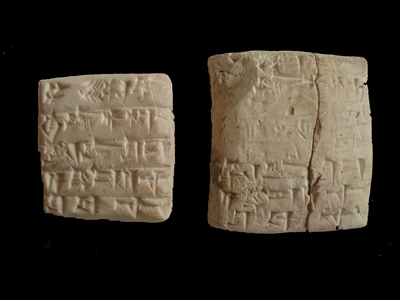
Grayish tan on one side and a good deal of tan showing through on the other. 1-1/2" long by 1-1/4" wide
| 1. giš hašhur sá-dug4 | an apple, a sacrifice |
| 2. bur-e-šú-a | in a bowl, covered, |
| 3. itu Še-kar-ra-gál-la-ta | from the month of Shekarragalla |
| 4. u4 8 ba-ra-zal-la-ta | from the 8th day in the morningg |
| 5. u4 5-šè é-gal-la | |
| 6. tur-ra | entered |
| 7. gír Ab-ba-gir | the "foot" (man) Abbagur |
| 8. itu Še-kar-ra-gál-laq | the month of Shekarragalla |
| 9. mu dGimil-dSin | the year Gimil-sin |
| 10. lugal Uri-ki- | the king of Ur |
| 11. ma | |
| 12. mà-gur8-mah | the lofty sail(?)-boat |
| 13. dEn-lil dNin-lil-ra | for Enlil and Ninlil |
| 14. mu ne-dim | he built for them.. |
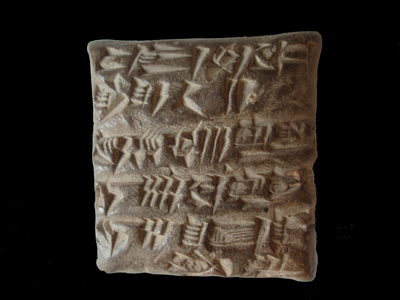
| BRIDWELL LIBRARY |
 |